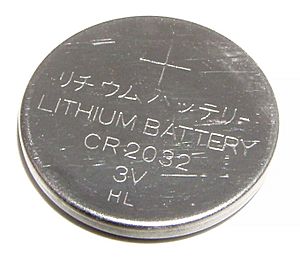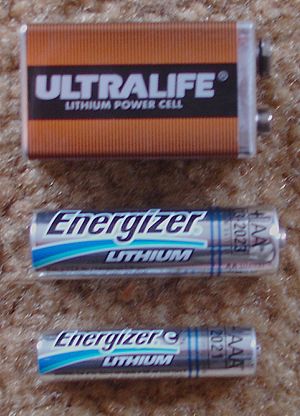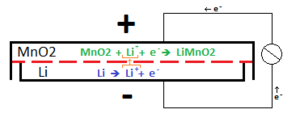Lithium metal battery facts for kids
Lithium metal batteries are special batteries that use a metal called lithium as a key part to make electricity. These batteries are mostly made to be used once and then thrown away, meaning they are non-rechargeable. However, scientists are working on new types that can be recharged.
These batteries are different from others because they can store a lot of energy for their size. They also cost more than regular batteries. Depending on how they are made and what chemicals are inside, lithium batteries can produce different amounts of power, from about 1.5 volts (like a normal alkaline battery) up to 3.7 volts.
It's important to know that these batteries are different from lithium-ion or lithium-polymer batteries. Those are the ones you can recharge, and they don't use pure lithium metal inside. Pure lithium reacts very quickly with water, even moisture in the air! The lithium in rechargeable batteries is in a safer form.
Lithium batteries are used a lot in small electronic gadgets you can carry around. There are many types of lithium metal batteries, but they all use metallic lithium to create power.
The most common type of lithium battery you might see uses metallic lithium and a chemical called manganese dioxide. It also has a special liquid called an electrolyte that helps the electricity flow.
Contents
History
Types of Lithium Batteries
There are many different kinds of lithium metal batteries, each with its own special uses. Here are a few common ones:
- Lithium-Manganese Dioxide (Li-MnO2): This is the most common type you'll find in stores. It's affordable and good for devices that don't need a lot of power but need to last a long time, like watches or calculators.
- Lithium-Iron Disulfide (Li-FeS2): These batteries can replace regular alkaline AA and AAA batteries. They last much longer, especially in devices that use a lot of power, like digital cameras. They also last a long time when stored.
- Lithium-Iodine (Li-I2): These batteries are super reliable and last a very long time. They are often used in medical devices like pacemakers because they are so dependable and don't produce gas.
Scientists at the University of California San Diego have even made special liquids (electrolytes) that let lithium batteries work in very cold temperatures, as low as -60°C! This could make batteries safer and more powerful in the future.
What Are They Used For?
Lithium batteries are used in many important devices that need to last a long time.
- Medical Devices: They are crucial for devices like pacemakers and other medical implants. These devices use special lithium-iodide batteries that can last 15 years or more inside a person's body.
- Everyday Electronics: You can find them in clocks, cameras, PDAs, watches, and digital cameras. Even though they cost more than regular batteries, they last much longer, so you don't have to change them as often.
- Ocean Equipment: Lithium batteries are also used in equipment placed in the ocean. They are more expensive, but they hold three times more power than other batteries. This higher cost is worth it because it's very expensive to send ships out to change batteries in remote ocean devices.
Sizes and Shapes
Small lithium batteries are very common in tiny electronic devices. They come in many shapes and sizes. A popular type is the 3-volt "coin" battery, like the CR2032. The "CR2032" name tells you its size: "20" means it's 20 millimeters wide, and "32" means it's 3.2 millimeters thick. A CR2025 battery is also 20 mm wide but only 2.5 mm thick.
Many modern gadgets need a lot of power quickly, and lithium batteries are great for this. They can provide a strong burst of electricity when needed, and they keep a steady voltage for a longer time compared to alkaline batteries.
Safety and Rules
Making batteries more powerful can sometimes push the limits of their parts, like the thin separator inside. This separator is only about 20-25 micrometers thick, which is thinner than a human hair! Since 1991, the amount of energy lithium batteries can hold has more than doubled, which puts more stress on these tiny parts.
Fast Discharge Dangers
Lithium batteries can release a lot of electricity very quickly if they are short-circuited (when the positive and negative ends touch directly). While this is useful for some devices, if a lithium battery discharges too fast, it can get very hot, break open, or even explode. To prevent this, consumer batteries usually have safety features like protection against too much current or vents to release pressure.
Air Travel Rules
Because of these risks, there are strict rules about carrying lithium batteries on airplanes. Since 2013, international rules have made it harder to ship loose lithium batteries by air. For example, you usually can't put loose lithium batteries in your checked luggage. You can carry them in your carry-on bag, but there are limits on how much lithium they can contain. Some countries even ban shipping lithium batteries by airmail unless they are already inside the device they power.
Swallowing Batteries
Small, round "button cell" batteries are very appealing to young children and are often swallowed. Over the past 20 years, even though the total number of swallowed batteries hasn't increased, the risk of serious injury or even death from swallowing them has gone up a lot.
When a button battery gets stuck, especially in the throat, it creates a chemical reaction that can cause severe burns very quickly. This can lead to serious problems like holes in the throat, damage to vocal cords, or even death. Most of the time, no one sees a child swallow a battery, and the symptoms can be vague. The 3-volt, 20 mm CR2032 lithium battery has been linked to many serious injuries in children under 4 years old.
If a child swallows a button battery, it's a medical emergency! Doctors recommend giving honey or a special liquid called sucralfate right away if you know or suspect a battery has been swallowed. This can help reduce the damage until the battery can be removed by a doctor. Button batteries can also cause serious harm if they get stuck in a child's nose or ears.
To help prevent these accidents, battery companies and device makers are changing how batteries are packaged and how battery compartments are designed, making it harder for children to get to them. However, it's still very important for everyone to know how dangerous these small batteries can be.
Getting Rid of Batteries
Rules for throwing away and recycling batteries can be different depending on where you live. Some places might let you throw used lithium batteries in the regular trash, especially if they don't contain chemicals that are controlled by federal laws.
However, some "button" size lithium batteries contain a chemical called perchlorate, which is considered hazardous waste in some places like California. It's always best to check with your local government or recycling center to find out the proper way to dispose of any batteries.
Images for kids
Error: no page names specified (help).
- List of battery types
- List of battery sizes
- Comparison of battery types
- Battery holder
- Battery recycling
- High capacity oceanographic lithium battery pack
- Lithium–air battery
- Lithium ion manganese oxide battery
- Lithium ion polymer battery
- Lithium iron phosphate battery
- Lithium–sulfur battery
- Lithium-titanate battery
- Nanoarchitectures for lithium-ion batteries
- Polyoxyethylene
- Thin film rechargeable lithium battery
See also
 In Spanish: Batería de litio para niños
In Spanish: Batería de litio para niños







